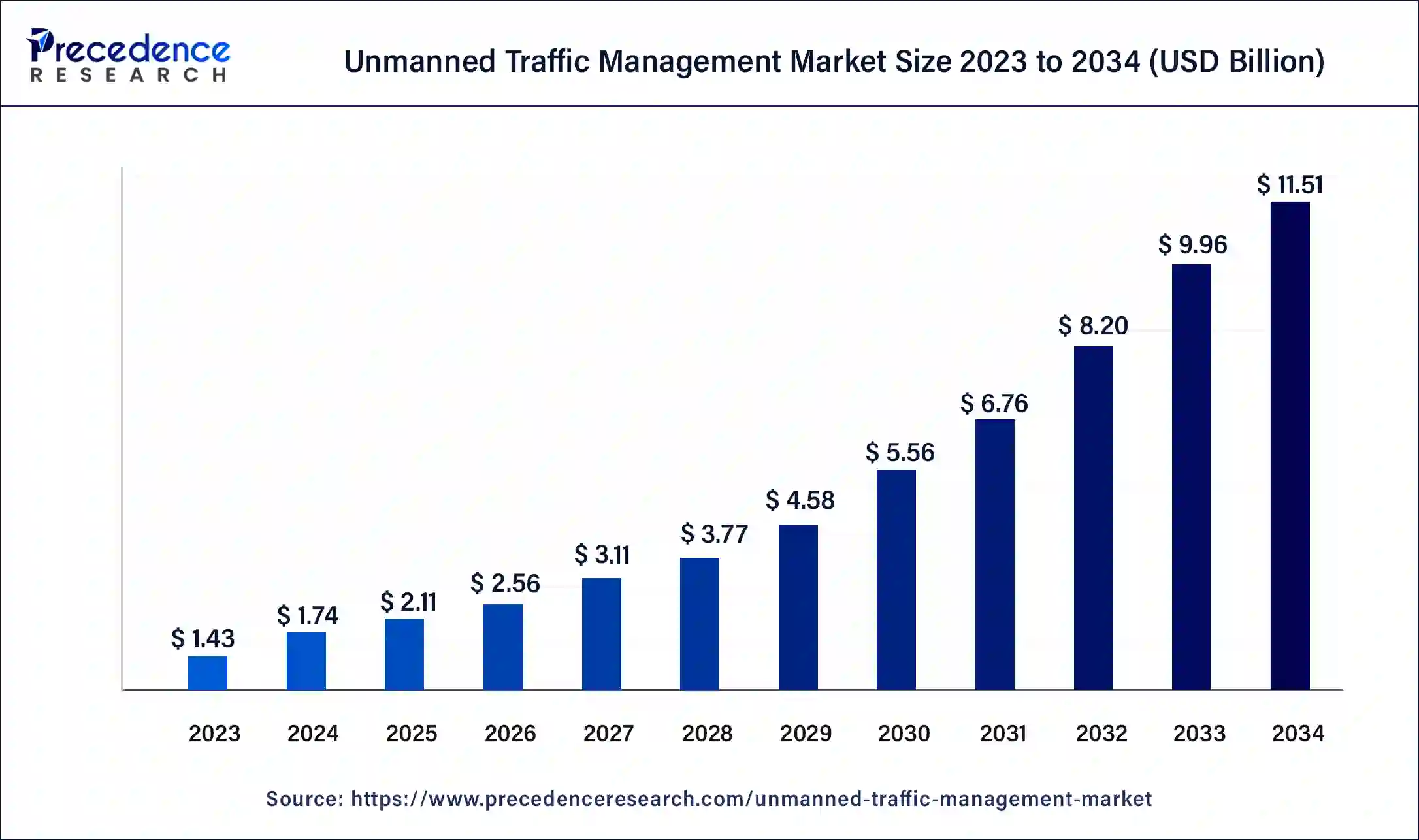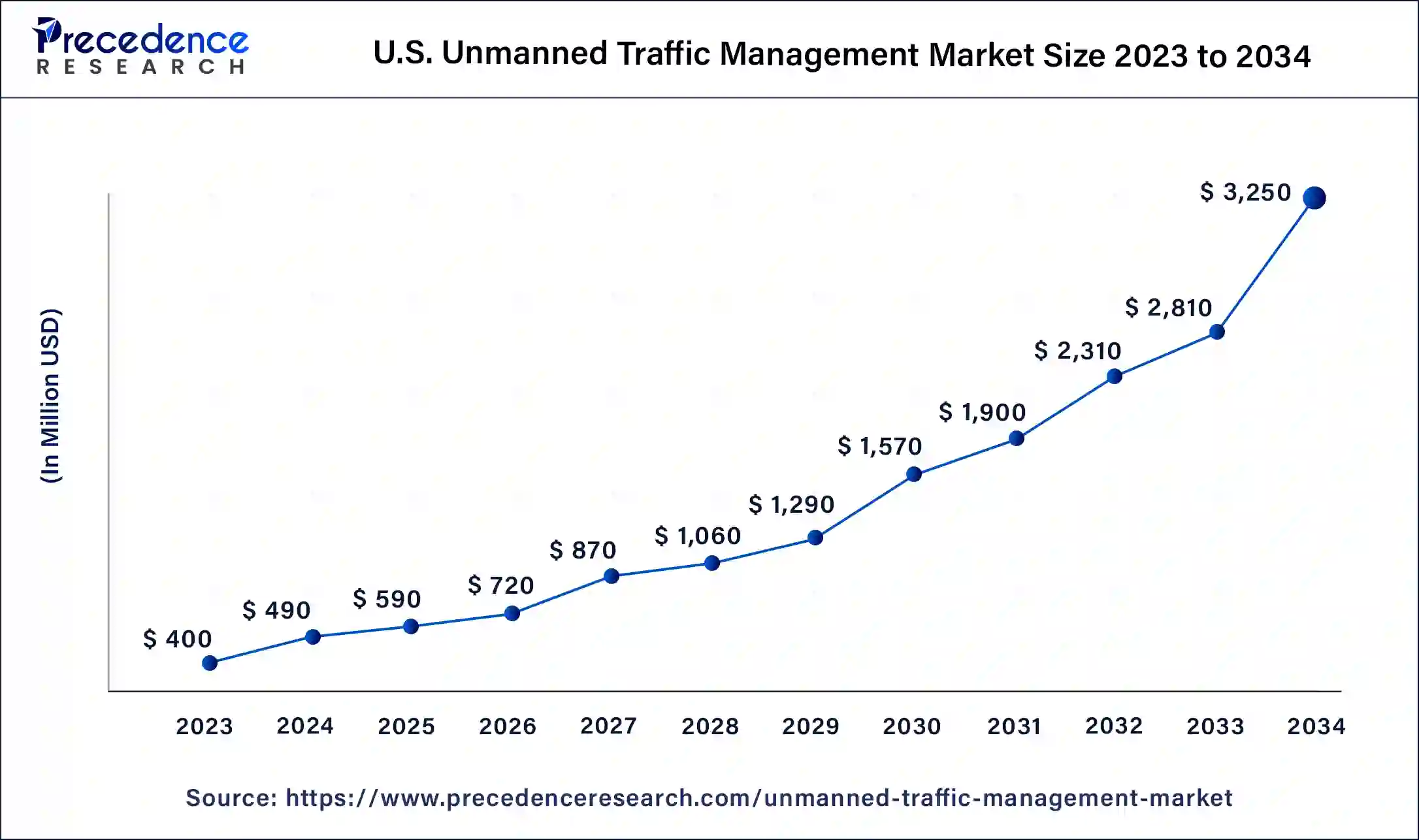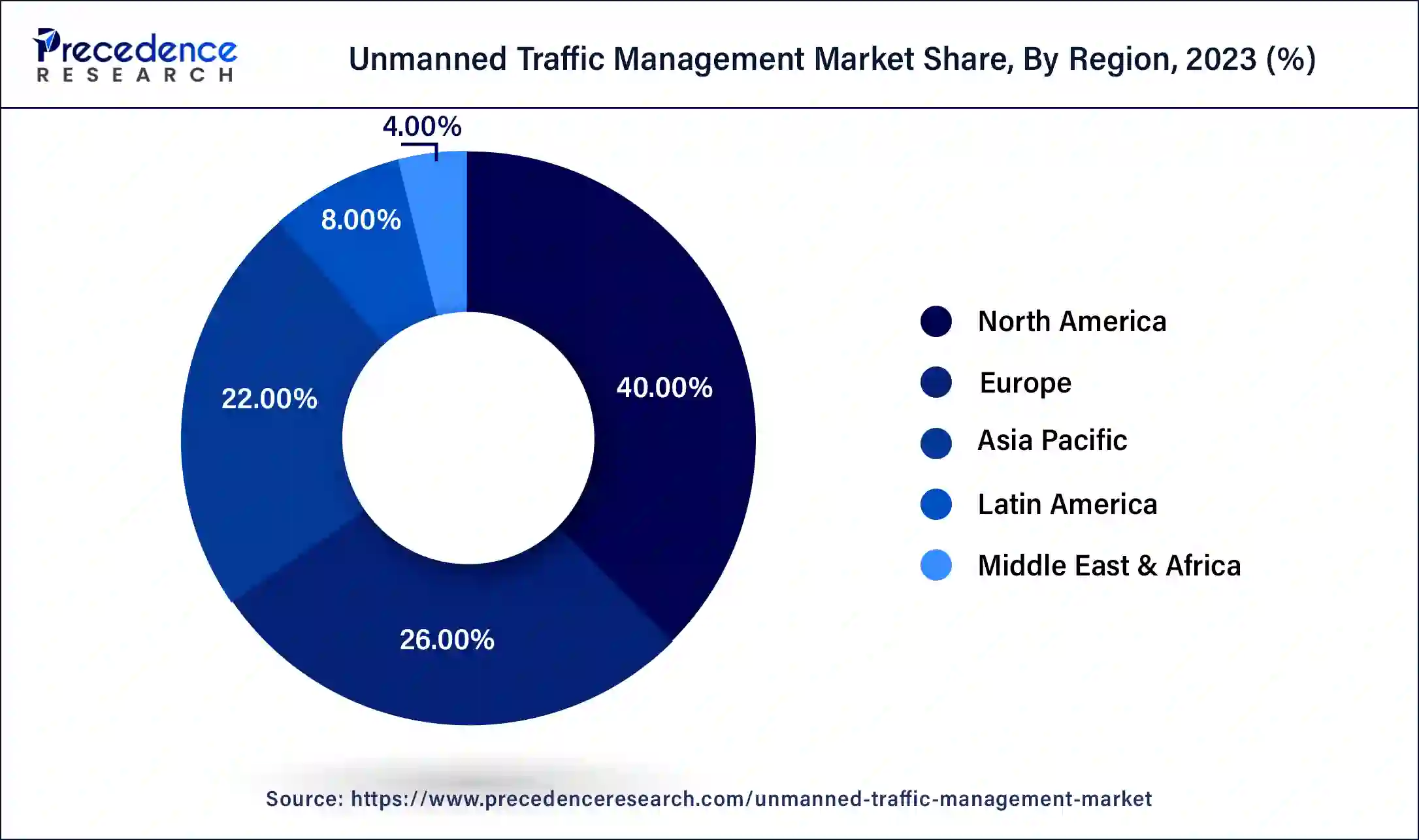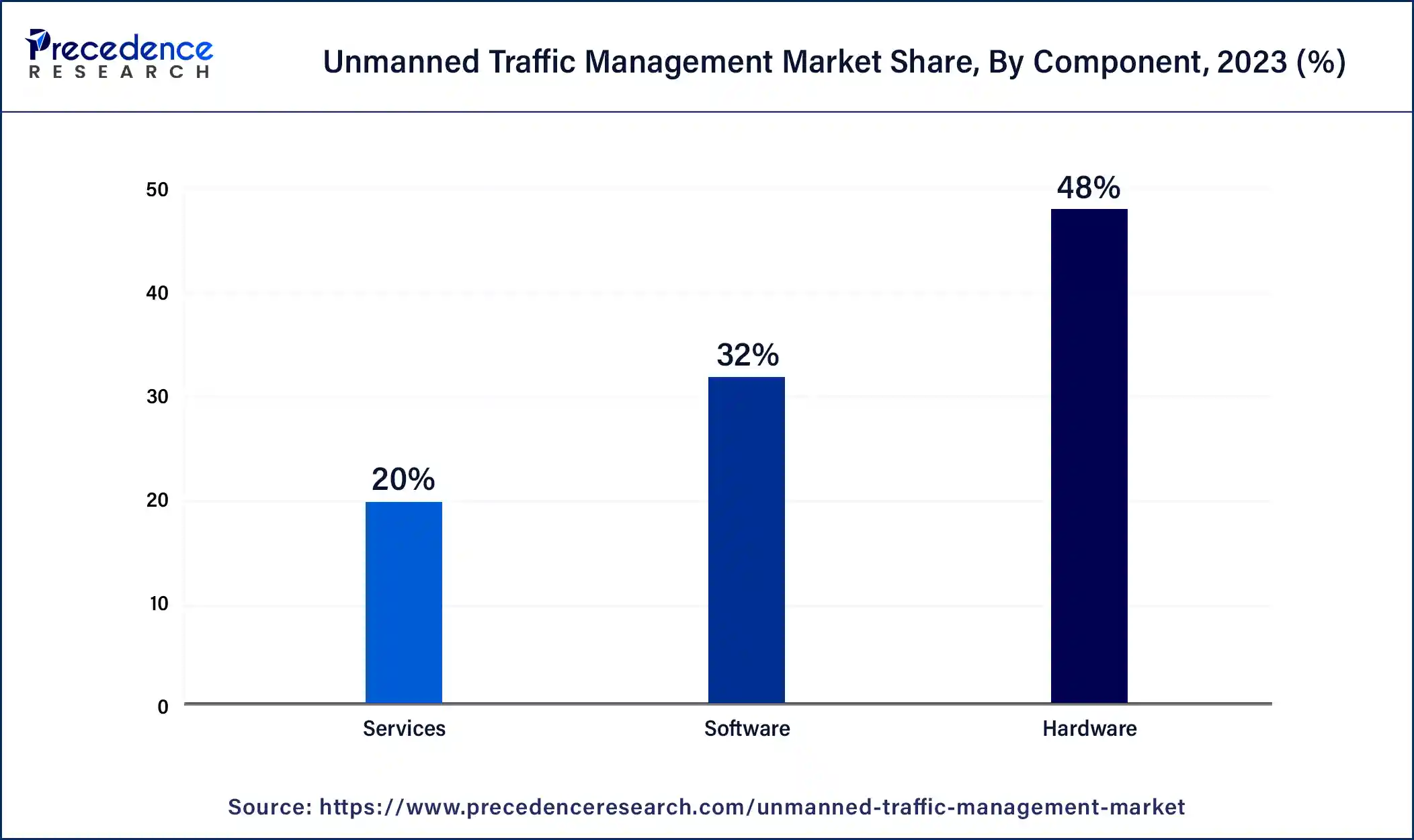List of Contents
Unmanned Traffic Management Market Size and Forecast 2025 to 2034
The global unmanned traffic management market size accounted for USD 1.74 billion in 2024 and is predicted to increase from USD 2.11 billion in 2025 to approximately USD 11.51 billion by 2034, growing at a CAGR of 20.80% from 2025 to 2034.

Unmanned Traffic Management Market Key Takeaways
- In terms of revenue, the global unmanned traffic management market was valued at USD 1.74 billion in 2024.
- It is projected to reach USD 11.51 billion by 2034.
- The market is expected to grow at a CAGR of 20.80% from 2025 to 2034.
- North America dominated the market with the largest revenue share of 40% in 2024.
- Europe is expected to grow to the highest CAGR in the market during the forecast period.
- By type, the persistent segment dominated the market in 2024.
- By type, the non-persistent segment is expected to grow to the highest CAGR in the market during the forecast period.
- By component, the hardware segment has held the largest revenue share of 48% in 2024.
- By component, the software segment is expected to grow to the highest CAGR in the market during the forecast period.
- By solution, the communication infrastructure segment dominated the market in 2024.
- By solution, the surveillance infrastructure segment is expected to grow to the highest CAGR in the market during the forecast period.
- By end user, the logistics & transportation segment dominated the market in 2024.
- By end user, the surveillance & monitoring segment is expected to grow to the highest CAGR in the market during the forecast period.
Unmanned Traffic Management Market Size in the U.S. 2024 to 2034
The U.S. unmanned traffic management market size was exhibited at USD 487.20 million in 2024 and is expected to be worth around USD 3286.39 million by 2034, expanding at a CAGR of 21.03% from 2025 to 2034.

North America dominated the unmanned traffic management market in 2024. With numerous businesses focusing on software development, telecommunication, and aerospace, the area is home to a booming technology sector. This innovation ecosystem draws talent and investment to the area by promoting the creation of state-of-the-art unmanned traffic management solutions. The drone applications span a wide range of industries in North America, from agricultural and public safety to infrastructure inspection and delivery service. In order to support the expanding drone industry, this demand drives investment in the unmanned traffic management infrastructure and service.
From disaster response and agriculture to law enforcement and entertainment, industries are increasingly adopting drones to carry out various operations. Moreover, the rising use of commercial drones has led to an increasing need for effective airspace management that allows drones to operate safely airspace. According to the Federal Aviation Administration (FAA), as of 4/1/2025, over 1 million total drones are registered and which includes 420,825 commercial drone registrations.
The United States, in particular, has taken the initiative to create legislation that would make it easier for drones to be integrated into the airspace. In order to create a favorable environment for businesses to develop and implement unmanned traffic management solutions, the Federal Aviation Administration (FAA) has been actively involved in the creation of rules and standards for the unmanned traffic management system.

Europe is expected to grow at the highest CAGR in the unmanned traffic management market during the forecast period. Europe's airspace management systems and strong legislative framework make it easy to integrate unmanned aerial vehicles into the airspace. Additionally, a substantial amount of money is spent on research and development, which promotes creativity and the uptake of unmanned traffic management solutions.
- In April 2021, the European Commission adopted the U-space package, three regulations that together create the conditions necessary for both drones and manned aircraft to operate safely in the section of airspace known as U-space. The regulations introduce new services for drone operators, allowing them to carry out more complex and longer-distance operations, particularly in congested, low-level airspace (below 120m) and when out of sight.
Market Overview
The unmanned traffic management market refers to systems and services created to control the growing complexity of drone activities in the airspace, which are referred to as the market. It contains technology for managing airspace, controlling drone traffic, communicating, and integrating with the current ATC system. Unmanned traffic management (UTM) systems are becoming more important in guaranteeing safe and effective drone operations as the number of drone applications grows.
- In 2023, the FAA published the UTM Implementation Plan in response to requirements from Congress in the FAA Reauthorization Act of 2018. This Plan addresses FAA's efforts to make UTM a reality, specifically its near-term and long-term plans, and the gaps in policy that must be resolved to have “full operational capability” of the UTM ecosystem.
Unmanned Traffic Management Market Growth Factors
- The growing demand for drones in commercial applications boosts the unmanned traffic management market.
- Growing budgets allocated to the defense sector worldwide.
- Rising need for different modes of transportation to cater to the growing population globally.
Unmanned Traffic Management Market Scope
| Report Coverage | Details |
| Growth Rate from 2025 to 2034 | CAGR of 20.80% |
| Market Size in 2024 | USD 1.74 Billion |
| Market Size in 2025 | USD 2.11 Billion |
| Market Size by 2034 | USD 11.51 Billion |
| Largest Market | North America |
| Base Year | 2024 |
| Forecast Period | 2025 to 2034 |
| Segments Covered | Type, Component, Solution, End-user, and Regions |
| Regions Covered | North America, Europe, Asia-Pacific, Latin America, and Middle East & Africa |
Market Dynamics
Drivers
Development of smart cities
The development of smart cities boosts the unmanned traffic management market. There is an intriguing relationship between unmanned traffic management and smart cities. Consequently, smart cities use a variety of technologies to improve productivity, sustainability, and the standard of living for citizens. This frequently incorporates sophisticated infrastructure management, communication, and transportation systems. The smart city infrastructure is essential for UTM, which is controlling drones and other unmanned aerial vehicles (UAVs) in low-altitude airspace.
According to the article published by the Ministry of Housing & Urban Affairs in December 2024, as of 15.11.2024, under the Smart Cities Mission (SCM), work orders have been issued in 8,066 projects amounting to INR 1,64,669 crore, of which 7,352 projects (i.e. 91% of total projects) amounting to INR 1,47,366 crore have been completed, as per the data provided by 100 Smart Cities.
Restraint
High cost and low return on investment
The high cost and low return on investment of unmanned traffic management slow down the unmanned traffic management market. A large infrastructure investment is necessary to implement a reliable UTM system. This investment includes systems for surveillance, ground control stations, communication networks, and regulatory compliance. For many parties involved, particularly smaller businesses or towns with tighter resources, these expenses may be unaffordable. UTM service providers occasionally could find it difficult to bring in enough money to cover their expensive overhead. This is especially true in areas where the need for UTM services is still developing or where the reach of UAV operations is restricted by regulations.
Opportunity
Collaboration between software and drone manufacturing companies
The collaboration between software and drone manufacturing companies can be the opportunity to grow the unmanned traffic management market. By combining cutting-edge software with manufacturing know-how to create cutting-edge unmanned traffic management systems, cooperation between software and manufacturing firms may propel the expansion of the unmanned traffic management industry. This partnership can improve unmanned aerial vehicle safety, effectiveness, and scalability by fusing state-of-the-art software for airspace management, navigation, and communication with the capacity to manufacture dependable hardware components.
In the unmanned traffic management market, collaboration can also result in the development of comprehensive unmanned traffic management platforms that address a range of industrial requirements, including public safety, infrastructure inspection, logistics, and transportation. Software and manufacturing businesses may take advantage of the growing need for UTM solutions and propel market progress by utilizing each other's advantages.
- In April 2024, Unifly, a leader in Unmanned Aircraft System traffic management technology, joined forces with Terra Drone Corporation and Aloft Technologies Inc. to develop a global UAS traffic management infrastructure. This collaboration, announced in Antwerp, seeks to facilitate the burgeoning Advanced Air Mobility (AAM) industry worldwide.
Type Insights
The persistent segment dominated the unmanned traffic management market in 2024. There is a growing need for unmanned aerial vehicles or drone management for dependable and continuous communication. The constant and dependable communication that persistent unmanned traffic management systems provide is essential for the real-time monitoring, control, and coordination of UAVs in a variety of applications, including infrastructure inspection, delivery, surveillance, and agriculture.
The increased use of UAVs in many businesses and sectors makes this dependability even more crucial. The development of the persistent category within the market may also have been aided by technological developments, such as better network infrastructure, improved data processing algorithms, and greater satellite communication capabilities. Persistent UTM systems can now handle large-scale UAV operations and are more effective and economical thanks to technological advancements.
The non-persistent segment is expected to grow rapidly in the unmanned traffic management market during the forecast period. When compared to persistent systems, non-persistent unmanned traffic management solutions frequently require less infrastructure investment. They can lower implementation costs for companies and organizations wishing to adopt unmanned traffic management capabilities by utilizing already-existing communication networks and technologies, such as Wi-Fi and cellular networks. Since non-persistent unmanned traffic management systems are frequently more adaptable and scalable, integrating them with various UAV kinds and operating conditions is made simpler. Industries and sectors that need dynamic and flexible unmanned traffic management solutions to match their changing demands find this flexibility appealing.
The technological developments in communication, including edge computing, 5G networks, and Internet of Things (IoT) devices, have greatly enhanced the dependability and performance of non-persistent unmanned traffic management systems. Non-persistent solutions have become more acceptable to consumers as a result of these technical improvements that increase data transfer speeds, decrease latency, and improve overall system responsiveness.
Component Insights
The hardware segment dominated the unmanned traffic management market in 2024. The unmanned traffic management systems are based on hardware, which includes physical devices, including sensors, ground control stations, communication equipment, and collision avoidance systems. Enabling communication, navigation, and surveillance capabilities is crucial for controlling drones, also known as unmanned aerial vehicles. The need for unmanned traffic management hardware components has increased as a result of the growing use of UAVs in a variety of fields and businesses, including public safety, construction, logistics, and agriculture.
Robust hardware solutions are required to enable safe and effective UAV control as more companies and organizations incorporate drones into their operations. To guarantee that unmanned traffic management systems adhere to safety standards and airspace laws, regulatory bodies and aviation authorities frequently impose certain hardware requirements. This entails fitting UAVs with transponders, navigational aids, and communication gear.

The software segment is expected to expand at a significant pace in the unmanned traffic management market during the forecast period. In order to meet the demands of different industries, operational sizes, and complexity, unmanned traffic management software may be made both scalable and configurable. Unmanned traffic management software may be customized to maximize performance, scalability, and flexibility in various use cases, whether it is assisting a small-scale drone delivery business or overseeing a large-scale UAV fleet for industrial inspections.
The unmanned traffic management software generates actionable insights and optimizes decision-making processes by utilizing data from sensors, UAVs, weather predictions, airspace conditions, and previous flight data. Unmanned traffic management system performance, risk management, and operational efficiency are all aided by the capacity to analyze massive volumes of data in real time, spot trends, find anomalies, and offer predictive analytics. From mobile devices or centralized command centers, unmanned traffic management software allows for the management, control, and observation of UAV activities remotely.
Solution Insights
The communication infrastructure segment dominated the unmanned traffic management market in 2024. Communication infrastructure is essential for smooth communication between the many parties involved in the unmanned traffic management ecosystem, such as drones, ground control stations, regulatory agencies, and other pertinent parties. It would be difficult to carry out efficient unmanned traffic management operations without a strong communication infrastructure. The high levels of scalability and dependability were probably given by the communication infrastructure options available in 2024, which are essential for controlling several drones at once.
Scalable communication systems are necessary to provide continuous coordination and communication as drone operations grow, particularly in metropolitan areas. It's possible that communication infrastructure solutions and unmanned traffic management systems are well-integrated, enabling effective data interchange, real-time updates, and drone flight coordination. The smooth integration increases unmanned traffic management systems' overall efficacy and increases their appeal to users and regulatory bodies.
The surveillance infrastructure segment is expected to grow rapidly in the unmanned traffic management market during the forecast period. The increasing use of drones in airspace raises serious security and safety issues. Radar systems, sensors, cameras, and other surveillance technologies are essential for keeping an eye on drone activity, spotting any threats, and guaranteeing that airspace laws are followed. It is anticipated that the need for sophisticated monitoring technologies will increase dramatically if these worries worsen. In order to improve safety and security, regulatory agencies frequently require unmanned traffic management operations to employ surveillance systems.
The adoption of surveillance infrastructure solutions by drone operators and unmanned traffic management service providers is fueled by compliance with these rules, which propels market expansion. Airspace violations, unapproved drone operations, and collision avoidance are just a few of the dangers that surveillance infrastructure helps to reduce. Modern surveillance systems provide automatic reaction, threat detection, and real-time monitoring.
End-user Insights
The logistics & transportation segment dominated the unmanned traffic management market in 2024. Because the market profits quickly and directly from efficient, economical operations. Unmanned traffic management lowers overhead costs and increases productivity for a variety of applications, including inventory management, delivery route optimization, and timely transportation. These sectors are leading the way in using technology that increases safety and accelerates operations since they mainly depend on smooth mobility and coordination.
The surveillance & monitoring segment is expected to grow at a substantial CAGR in the unmanned traffic management market during the forecast period. The necessity to keep a check for harmful or illegal activity in airspace has increased with the use of drones and other unmanned aerial vehicles.
Unmanned Traffic Management Market Companies
- Airbus SE
- AirMap Inc.
- Altitude Angle Limited
- Droniq GmbH
- Frequentis
- Intelligent Automation (IAI)
- Leonardo S.P.A
- Lockheed Martin Corporation
- L3Harris Technologies, Inc
- Nova Systems
- OneSky Technology Pte. Ltd
- Precisionhawk Inc
- Terra Drone Corporation
- Thales
- Unifly NV
Recent Developments
- In April 2025, Terra Drone Corporation, a global leader in UAS traffic management solutions, Unifly, participated in the ENSURE Project, which the SESAR 3 Joint Undertaking is leading, focusing on working safely to integrate drone operations with manned aircraft in Europe's skies.
- In December 2024, Avinor, the Norwegian air navigation service provider, announced that it had selected Thales to deploy a next-generation unmanned traffic management (UTM) system, enhancing airspace management for both unmanned and manned aircraft while ensuring full compliance with European regulatory standards.
- In February 2024, AIRmarket and Alberta announced the investment of over USD 4.7 million in Canada's First RPAS traffic management system to accelerate the drone economy and cut emissions significantly. AIRmarket Inc. is one of the leaders in the development of an advanced communications network for drone control and airspace surveillance with the support of the Government of Alberta (GoA).
- In April 2024, the Ohio Department of Transportation (ODOT) launched what is believed to be the first state-level, low-altitude unmanned traffic management navigation system. The Federal Aviation Administration-led (FAA) initiatives have explored UTM test deployments and partnerships with private industry.
- In April 2024, Aloft Technologies, Inc., a leader in drone technology solutions, today announced a groundbreaking integration with Skydio, the leading U.S. drone manufacturer and world leader in autonomous flight technology, to integrate Live UTM Telemetry.
- In February 2023, Skye Air, a Gurugram-based drone solutions provider, launched a traffic management system for drones in India. Launched in the presence of Minister of Road Transport and Highways of India Nitin Gadkari, the software will allow drone operators to plan routes, make flight plans, and assess risks before running drone-based operations in the country.
Segments Covered in the Report
By Type
- Persistent
- Non-persistent
By Component
- Hardware
- Software
- Services
By Solution
- Communication Infrastructure
- Navigation Infrastructure
- Surveillance Infrastructure
- Others
By End-user
- Agriculture & Forestry
- Logistics & Transportation
- Surveillance & Monitoring
- Others
By Geography
- North America
- Asia Pacific
- Europe
- Latin America
- Middle East & Africa
For inquiries regarding discounts, bulk purchases, or customization requests, please contact us at sales@precedenceresearch.com
Frequently Asked Questions
Ask For Sample
No cookie-cutter, only authentic analysis – take the 1st step to become a Precedence Research client